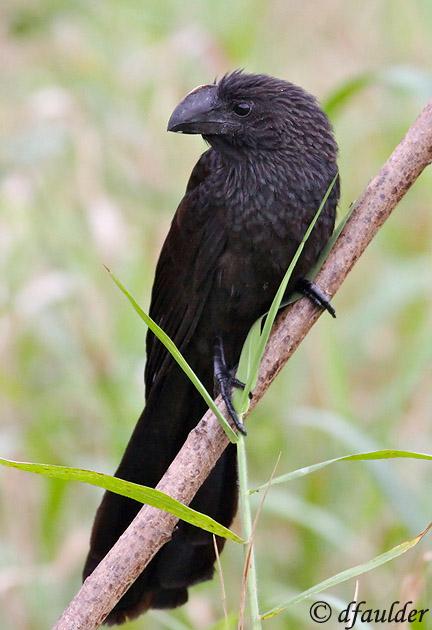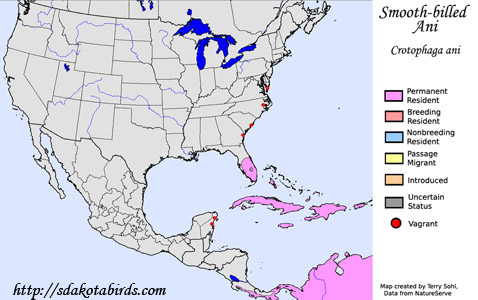| Length: 13 inches | Wingspan: 17 inches | Seasonality: Non-resident in South Dakota |
| ID Keys: All black, massive bill, shaggy-looking plumage | ||
 The
Smooth-billed Ani is a relatively newcomer to the United States, with the
first birds appearing in Florida in the late 1800s. They evidently
naturally expanded from Caribbean populations, and populations increased in
Florida until about the 1970s. Since then, U.S. populations have been
in decline, and they are now a rare resident in much of Florida.
Populations are widespread in the American tropics, however, with strong
populations in the Caribbean, Central America, and South America.
The
Smooth-billed Ani is a relatively newcomer to the United States, with the
first birds appearing in Florida in the late 1800s. They evidently
naturally expanded from Caribbean populations, and populations increased in
Florida until about the 1970s. Since then, U.S. populations have been
in decline, and they are now a rare resident in much of Florida.
Populations are widespread in the American tropics, however, with strong
populations in the Caribbean, Central America, and South America.
Habitat: Found in brushy areas, dense underbrush at woodland edges, and other brushy areas with nearby open areas.
Diet: Feeds mostly on large insects such as beetles, caterpillars, moths, and grasshoppers, as well as other insects, spiders, and occasionally small lizards, frogs, and snakes.
Behavior: Most foraging is done on the ground, where they walk around, searching for insects.
Nesting: Nests communally, with multiple "families" helping to build a large bulky nest of twigs and pieces of other vegetation. Multiple females lay eggs in the nest, with multiple birds helping to incubate the eggs and raise the young when they hatch.
Song: Makes a variety of cackles and whistling calls, with the most common vocalization a whining whistle that ascends in pitch.
Migration: Considered non-migratory throughout its range.
Interactive eBird map: Click here to access an interactive eBird map of Smooth-billed Ani sightings
Similar Species: Groove-billed Ani
Conservation Status: Globally, Smooth-billed Anis have a wide distribution, and clearing of tropical forests has led to expansion of populations. The IUCN lists them as a species of "Least Concern".
Further Information: 1) WhatBird - Smooth-billed Ani
2) Everglades National Park - Smooth-billed Ani
3) Audubon - Smooth-billed Ani
Photo Information: Photo taken by dfaulder - Photo licensed under Creative Commons Attribution 2.0 Generic License
| Click below for a higher-resolution map |
 |
| South Dakota Status: Non-resident in South Dakota |
Additional Smooth-billed Ani Photos (coming soon!!)
